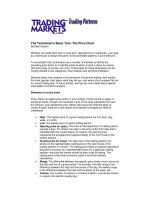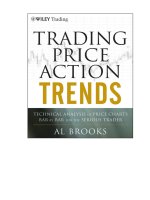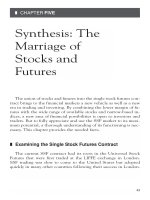Trade the price action laurentiu damir
Bạn đang xem bản rút gọn của tài liệu. Xem và tải ngay bản đầy đủ của tài liệu tại đây (1.76 MB, 43 trang )
Trade the Price Action
By Laurentiu Damir
Copyright ©2012 Laurentiu Damir
All rights reserved. No part of this book may be reproduced or transmitted
in any form or by any means, electronic or mechanical, including photocopying,
recording, or any information storage and retrieval system, without prior written
permission of the Author. Your support of author’s rights is appreciated.
Table of Contents
Strategy Introduction
No indicators
Timeframe
Trend
Support and Resistance
Fibonacci Retracements
Candlestick patterns
Hammer
Engulfing pattern
Morning star/Evening star
Dark cloud/ Piercing pattern
Strategy step by step
Patience is the key
Strategy Introduction
I have been trading currencies with decent success so far and I decided to
present to you my complete detailed trading system. This strategy addresses
people that have yet to succeed in the currency market, the people that have
been trying hard to construct a winning strategy that will allow them to make
some profits in the forex market. I know this process is very frustrating but you
have come to the right place. I’ve put together this powerfull strategy for myself
after about one and a half years of frustration when everything I tried did not
seem to work for me at all. After all that screen time, studying the charts
endlessly, reading countless books, articles, forums, I have come to the
conclusion that the most powerful things, the things that work best in the foreign
exchange market are the following: trend, support and resistance zones (both
horizontal and diagonal), Fibonacci ratios and candlestick patterns/price
patterns. Consequently, I came up with this price action strategy that
incorporates all of the above, and since then, things have been working out
great for me.
No indicators
As this is a strategy based on price action, it doesn’t use technical indicators.
As far as I am concerned all indicators are lagging behind the price because of
the simple fact that they are constructed with past price information.This makes
them useless in predicting future price movements. The price action itself is the
best indicator that you can have to help you make a lot of winning trades in the
foreign exchange market. You just need to learn how to read it and this is
exactly what you will find out with this strategy. The only indicator that I find
useful is the 200 period exponential moving average or 200EMA applied on the
daily chart, but not because it has the ability to predict future price movements,
after all, it is just like any other indicator based on past price action, but for the
fact that a large majority of the traders out there seem to be keeping an eye on
it to the point that it becomes self fulfilling. If you look at a daily chart with the
200 EMA on it you will see that price very often reacts at or near this moving
average which means that there are a lot of traders that take into account this
200EMA and base some of their trading decisions on it. The exact same story
is valid for the candlestick patterns. The strategy I made includes the 200 EMA
inserted on the daily chart, but only for confirmation that it is in line with our
price action reading, we do not base trading decisions on the moving average.
Timeframe
The 4hours timeframe zoomed out to the maximum is the best timeframe to
trade if you want to make money. A smaller timeframe than the zoomed out 4h
is intraday trading and it won’t make a very successful trader out of you in the
long term because of the many random price moves on the lower timeframes
generated by the never ending economical news . The zoomed out 4h chart
gives you an overview of what is going on in the market, it tells you which is the
dominant trend and how you can profit from it. Trading on smaller timeframes is
very risky and I do not recommend it. In this strategy I use the 4h timeframe,
as it is a conservative strategy, it is designed to make you money in the long
run, and you will find that it is extremely reliable. This is not a get rich quick
type of forex strategy, you will not be making trades all day long, every day of
the week. Substantial profits are made with just a few trades per month. Also,
your live account platform from your broker has to have the New York closing
time for their charts, if they don’t, use a demo account from a broker that has
this like Fxdd or Fxlite, do all the preparation work on that demo account and
use the live account only to ente the trades into the market. Now, I will walk
through the components of the strategy I mentioned earlier and discuss them in
detail.
Trend
This is the most important part of the strategy. I will explain how to identify the
trend by looking at price action, which is the most reliable way to do it. As you
probably know, you have a trend in place as the price starts to make higher
highs (HH) and higher lows (HL) or lower highs (LH) and lower lows (LL). Here
is an example of a downtrend:
Now let’s see an uptrend:
As you can see, when a trend is in place, price goes strong in one direction,
than it corrects itself going in the opposite direction or just stalling/ranging for a
period of time and after that, another impulsive move in the initial direction,
another correction and so on. This is what constitutes a trend.
The important thing when identifying highs and lows is paying attention to see if
they are of the same amplitude, like in the picture above for example. Here is
what I mean:
In the same example after the third HH price made a very small move in the
direction of the trend followed by a very small correctional move (circled in the
picture above). That is not a HH as it is not of the same size or amplitude like
the previous HH’s. That is a small wave within the bigger wave.
One more example to illustrate this:
In this example you habe the same situation where there are small waves
contained by the bigger wave. This bigger wave is the one that has significance
for the overall price action on this timeframe, those three minor waves are of a
smaller degree and they should not be taken into account when deciding how to
label your trend on this timeframe. Okay, now that you have an idea about how
to identify a trend, let’s see how a trend changes its direction and identify that
exact moment from a technical point of view.
In the chart above you can see we have not one but two changes of trend.
Starting from the left we see a clear downtrend with the price making LH and
LL. In order for the trend to change we have to see a breach of the last LH,
right at that horizontal line. Until that happens the trend is still down.
You can see that eventually the price broke the last LH, made a small
correction and then continued upwards changing the trend from a downtrend to
an uptrend. So, the trend changed when price stopped making LH, broke the
last LH and made a distinct point in the market situated higher than the last
lower high. This point on the above chart is the first HH that price makes after
breaching the last LH of the downtrend. After this we can see another change
in trend from uptrend to downtrend. The price continues up and makes three
HH’s, but it cannot make a third HL as price, like in the first change of trend,
breaches the last HL at the second horizontal line in this chart to make a new
low at a price level which is lower than where the last HL of the uptrend is
situated. It then makes a correction move and goes straight down confirming
that a LL has been formed and a change in trend has taken place. Remember,
a change in trend only takes place after the last LH or HL is breached, price
makes a correction and shoots through the newly formed HH or LL confirming
the validity of that new HH or LL. Only at this time you know that the trend has
changed. Here is another example to understand the importance of this:
In the example above we have a clear long term uptrend on AUD/USD. Now, in
order for this uptrend to be broken, price had to breach the last HL, retrace or
correct and then go down past that point to confirm that the new LL has been
formed and a change in trend has taken place. As you can see, it did not do
that, it only spiked bellow the last HL and then sharply retraced back up and
never came down again to confirm the LL and the trend change. So the trend
on the AUD/USD is still up. OK, there is one more important thing that you have
to know when you study the chart to see what is the trend. I told you already
that a new high or new low has to be confirmed by price consistently going
above or bellow it. Let’s take the same chart as the one above to explain
better:
You can see that after the second HH, price made a consistent move above it ,
practically validating that it is indeed a HH. When price gets right at the top to
that circled potential HH, it retraced and tried to move above past it to continue
the uptrend and confirm the HH. It only managed to go 50 pips above it and
then retraced sharply.This was not at all a strong move above that level so the
HH circled in the above chart was not confirmed.
The same applies to that new potential HL that could have been valid only if
price would have gone strongly up. After this failure to confirm a potential HH
and HL, the HH that remains valid is the one labelled „NEW HH” and the last
low is still the second HL in the chart above.
All right, now you know how to spot a trend, with a little practice on your charts
you will have no problem in identifying the correct trend and then try to profit
from it. Let’s move on now to the other components of this strategy.
Support and Resistance
You probably already know that support and resistance are zones where price
has reversed direction in the past. For example all the highs and lows in the
above charts are minor support and resistance zones. Major support and
resistance are those areas where price has repeatedly reversed direction. The
more times price touches a level of price and then reverses, the more stronger
that support or resistance is. There is also diagonal support-resistance or trend
lines which work the same way as horizontal support-resistance. The important
thing to remember about support and resistance is that when you have a trend
in place, a broken resistance turns into support and a broken support turns into
resistance. I will show some charts for better understanding:
We have here a downtrend, all those lines are in fact lower lows that price
broke to make new lower lows so they were minor support and after they have
been broken they turned into minor resistance as you can see by the fact that
after each of that zone was breached price came back up to retest it and every
time it bounced back down.
Here we have a major pivotal support turned resistance and then support again
where price has reversed multiple times coming from both sides of it. Here is
another example of such a level.
The important thing for you to remember about these powerful pivotal levels in
the market is that they tend to attract price action. The stronger the level is, the
greater the chances are that price will revisit the level sooner rather than later.
Think of these levels as fair price or fair value for a forex pair. When buyers or
sellers feel that they do not have sufficient grounds to push the price strongly in
one direction or another meaning that there isn’t a strong trend, price will
always go to revisit these strong pivotal zones in the market. They are like a
magnet for price action.
Here we have a diagonal support or a trend line as it is more commonly known.
These diagonal levels are just as important as the horizontal ones but they do
get broken faster. In this example you can see a trend line that was touched
three times by price action. In the majority of situations, when price comes
back to the trend line for the forth time it will break it and cross below it. Like
horizontal support and resistance levels these too act as pivotal levels in the
market as you can see in the illustration below.
Okay, I think it is pretty clear now what support and resistance are. Let’s move
on.
Fibonacci Retracements
This is a tool that works great in the forex market. The vast majority of traders
use it to find areas where to enter their trades. In fact the Fibonacci
retracements are just another form of support and resistance. Let’s see some
examples to find out how well they work:
You can see, trend had just changed from down to up , price corrects itself
exactly to the 78.2% retracement level and then rallies.
Downtrend, correction to the 50% retracement and then all the way down.
Uptrend, correction to the 61.8% retracement level and then rally. From my
experience , the 50% retracement is by far the most reliable, followed by the
61.8% and the 78.2% in this order.
There is also the 38.2% retracement level but I don’t use it because I don’t
think it is a complete correction, the price has to correct to 50% or more. There
is of course the possibility that price retraces 100% of the previous move and it
should be taken into account but the strongest level is by far the 50%. Also, an
important aspect when plotting the fibonacci retracements on the chart is to
see if there is confluence between a fibonacci level and a previous
support/resistance zone like below:
You can see in the chart above that the 61.8% retracement where the price
reverses and resumes the downtrend coincides with minor resistance
represented by the last lower low. This is a stronger signal that the trend down
will resume at this point because price has reached the 61.8% retracement
level and at the same time that level coincides with a resistance zone. If we
have confluence of fibonacci retracement level with a trendline it is an even
stronger indication. If we have confluence of all three at the same level that is
the strongest possible signal that the trend will resume.
Look at the chart above, we are in a very strong uptrend, we have a trendline in
place, price comes back down and makes a correction to the 61.8%
retracement level which coincides with the trendline.
This is a strong signal. Furthermore, after that it comes back to the 50%
retracement level which is also right at the trendline again and is also minor
support represented by the last higher high. This is a very strong signal. In
conclusion, the more confluence of events at a specific price zone , the more
stronger the indication that the trend will resume from that point on. Ok, we
now know in detail how to correctly identify a trend, we know about
support/resistance zones and all about the Fibonacci retracement levels and
how powerfull they are in conjunction with other support/resistance zones. Let’s
move on to the last component of this strategy.
Candlestick patterns
As you probably know, candlestick patterns are used best as a confirmation
when to enter a trade if a price action setup has been spotted. I will give
examples of candlestick patterns that from my experience are the most
powerfull.
Hammer:
This is the most powerfull of them all. When this happens at an extreme like in
the chart above, chances are price is going to reverse for a while. And it did,
even though the second hammer was a bullish one it still pushed the price up
for more than 150 pips which is remarkable considering the trend was down at
that time.
Engulfing pattern:









